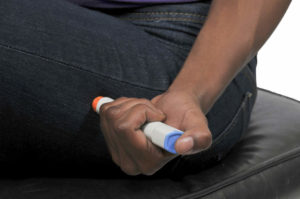Allergies to Moisturizers
 Excessive dryness of the skin is a feature of many chronic dermatological disorders and contributes greatly to itchy skin. Regular application of a moisturizer is critically important in the prevention and treatment of atopic dermatitis (i.e., eczema) or eczematous-like conditions such as contact dermatitis.
Excessive dryness of the skin is a feature of many chronic dermatological disorders and contributes greatly to itchy skin. Regular application of a moisturizer is critically important in the prevention and treatment of atopic dermatitis (i.e., eczema) or eczematous-like conditions such as contact dermatitis.
There are hundreds of different moisturizing products available over the counter. A recent article published in the JAMA Dermatology journal offers some guidance on how to choose the right product for most individuals
A total of 174 unique best-selling moisturizer products were identified in the cohort study. The median price per ounce was $0.59 with a wide range varying between $0.10 and $9.51 per ounce. This represents a tremendous range of 9,400%. The most popular type of moisturizers were lotions (59%), followed by creams (13%), oils (12%), butters (8%), and ointments (2%).
Contact dermatitis is the condition that results in chronic inflammation of the skin, triggered by exposure to a chemical allergen or irritant. The study found that some moisturizers contain common chemical allergens, potentially worsening the very condition it is designed to treat!
The North American Contact Dermatitis Group (i.e., NACDG) publishes a list of most of the chemical allergens that play a role in the causation of contact dermatitis. The three most common allergens in moisturizers were fragrance mix, paraben mix, and tocopherol (i.e., DL-a-tocopherol). Most of the moisturizers contained more than one allergen. In fact, 43% of the moisturizers contained three to four allergens while 13% contained five or more allergens.
Even products with a claim of “fragrance free,” 45% of the moisturizers had at least one fragrance cross-reactor or botanical ingredient. When an individual is allergic to one fragrance, the risk of having a reaction to other fragrances is much higher because of the chemical similarity between ingredients.
Lotions were statistically less expensive per ounce than butters, creams, and oils. Products without any ingredients in the North American Contact Dermatitis Group’s list of allergens were not statistically more expensive per ounce than products with one or more allergens.
The most common potential allergens of the 174 best-selling moisturizer products are as follows:
- Fragrance mix
- Paraben mix
- Tocopherol (i.e., DL-a-tocopherol)
- Phenoxyethanol
- Formaldehyde releasers
- Propylene glycol
- Benzyl alcohol
- Iodopropynyl butylcarbamate
- Cocamide diethaholamine
- Methylisothiazolinone
- Compositae mix
- Lanolin
- Lavandula angustifolia oil
- Ethyl acrylate
- Benzophenone-3
- D-Limonene
- Melaleuca alternifolia
The study also found that the three most affordable moisturizers that were free of ingredients listed by the North American Contact Dermatitis Group included Ivory raw unrefined shea butter; Vaseline original petroleum jelly, and Smellgood African shea butter.
In addition to a comprehensive history and physical examination, diagnostic patch testing is often performed in order to identify the allergen(s) that may be causing any skin manifestations such as redness, dryness, itching, burning, peeling, scaling, and/or blistering. Identifying the allergen is very important, since treatment is aimed at avoiding contact with the offending allergen found in a moisturizer. Patch testing can also identify other chemicals and metals typically found in an array of products and used in various industries. These products may include cosmetics, hair dyes and other dyes, shampoos, rubber products, fragrances and perfumes, caine medications (e.g., benzocaine, tetracaine, dibucaine), industrial chemicals, topical antibiotics, topical anti-fungals, soaps, metals, jewelry, adhesives, sealants, paints, pine oil cleaners, dermatological creams, bandages, flavoring agents, glues, leather goods, shoes, pesticides, creams, lotions, ointments, oils, sunscreens, coolants, plastics, building materials, vaccines, corticosteroids, and textiles.
The board certified allergists at Black & Kletz Allergy see patients of all ages and have over 50 years’ experience in the field of allergy, asthma, and immunology. Skin disorders such as eczema, contact dermatitis, poison ivy, poison oak, poison sumac, hives (i.e., urticaria), generalized itching (i.e., pruritus) are common skin ailments that we routinely diagnose and treat. Black & Kletz Allergy has 3 offices in the Washington, DC, Northern Virginia, and Maryland metropolitan area. Our offices are located in Washington, DC, McLean, VA (Tysons Corner, VA), and Manassas, VA and all locations have on-site parking. The Washington, DC and McLean, VA offices are Metro accessible and we offer a free shuttle that runs between our McLean, VA office and the Spring Hill metro station on the silver line. To make an appointment, please call us or alternatively, you can click Request an Appointment and we will respond to your request within 24 hours by the next business day. The allergy doctors at Black & Kletz Allergy are happy to answer any questions or concerns you may have about any allergic, asthmatic, or immunologic issue.

